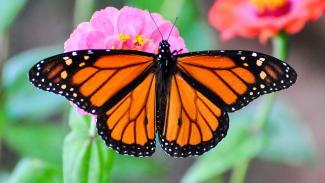
Image Credit: Peter Miller
Identification: Uppe rside of male is bright orange with wide black borders and black veins; hindwing has a patch of scent scales. Upper side of female is orange-brown with wide black borders and blurred black veins. Both sexes have white spots on borders and apex. The Viceroy butterfly (Limenitis archippus) is a Mullerian mimic; it has similar coloration and is also distasteful.
Wing Span: 3 3/8 - 4 7/8 inches (8.6 - 12.4 cm).
Caterpillar Hosts: Milkweeds including common milkweed (Asclepias syriaca), swamp milkweed (A. incarnata), and showy milkweed (A. speciosa); and milkweed vine in the tropics. Most milkweeds contain cardiac glycosides which are stored in the bodies of both the caterpillar and adult. These poisons are distasteful and emetic to birds and other vertebrate predators. After tasting a Monarch, a predator might associate the bright warning colors of the adult or caterpillar with an unpleasant meal, and avoid Monarchs in the future.
Adult Food: Nectar from all milkweeds. Early in the season before milkweeds bloom, Monarchs visit a variety of flowers including dogbane, lilac, red clover, lantana, and thistles. In the fall adults visit composites including goldenrods, blazing stars, ironweed, and tickseed sunflower.
Habitat: Many open habitats including fields, meadows, weedy areas, marshes, and roadsides. Less common in Portland area.